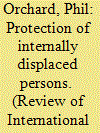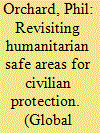|
|
|
Sort Order |
|
|
|
Items / Page
|
|
|
|
|
|
|
| Srl | Item |
| 1 |
ID:
111919


|
|
|
|
|
| Summary/Abstract |
The Responsibility to Protect doctrine (R2P), now ten years old, has been widely accepted at the international level. As the books under review demonstrate, debates around its legitimacy are over. Instead, we see a developing second generation of literature focusing on how the R2P needs to be understood more concretely in both academic and policy terms, as well as how it affects the linked issues of humanitarian intervention and state-building. Within this literature, we see new and important questions emerging. These include how and when we should intervene and whether we can be successful at it; how we can assist states to ensure they fulfill their own responsibilities towards their populations; and where international authority lies. Unfortunately, the answers to these questions are hard ones. Implementation, and how it reflects embedded culture at the international level, may be as hard-if not harder-as introducing the doctrine originally.
|
|
|
|
|
|
|
|
|
|
|
|
|
|
|
|
| 2 |
ID:
095610


|
|
|
|
|
| Publication |
2010.
|
| Summary/Abstract |
Internal displacement is increasingly perceived as an international problem. This has led to suggestions that international norms have begun to govern state behaviour towards their own displaced populations. I argue that this change occurred through the innovative use of soft law, in particular the guiding principles on internal displacement, by a consortia of norm entrepreneurs including NGOs and a UN Office, that of the Representative of the Secretary-General for Internally Displaced Persons. As soft law, these principles lack the usual markers which suggest an emerging norm. Instead, the article argues that alternative methods - including the international recognition of the principles and their adoption in domestic legislation - has triggered a change in state behaviour. This is demonstrated by examining two cases of forcible return of IDPs - the closure of the Kibeho Camp in Rwanda in 1995, before the principles were created, and the closure of the Znamenskoye camp in Ingushetia, Russia in 2002, after their creation. Both situations are similar in that the norm appears to have been rejected - forced repatriation did occur. In the Russian case, however, government statements, along with widespread international condemnation of the closures, suggest rhetorical instantiation of a norm of non forcible return for IDPs.
|
|
|
|
|
|
|
|
|
|
|
|
|
|
|
|
| 3 |
ID:
129032


|
|
|
|
|
| Publication |
2014.
|
| Summary/Abstract |
Are safe areas an effective option to protect civilian populations from mass atrocities when they are targeted by their own state? Safe areas disappeared from the international lexicon following the failures in Bosnia and Rwanda. But they are now receiving a second look as a way of responding to mass atrocities without full-scale military intervention. This article argues that the earlier generation of safe areas failed not due to their size or cost, but rather because of problems inherent with their underlying logic. Safe areas were based either on logics of consent or the presence of a credible military force. Hybrid safe areas (such as in Bosnia) were based on neither of these, but instead relied on the legitimacy inherent in the UN Security Council. Crucially, in cases where civilians were being directly targeted by belligerents, both hybrid and consent-based safe areas collapsed. This has direct ramifications for present discussions around the Protection of Civilians agenda and the Responsibility to Protect doctrine.
|
|
|
|
|
|
|
|
|
|
|
|
|
|
|
|
| 4 |
ID:
170260


|
|
|
|
|
| Summary/Abstract |
The International Criminal Court Pre-Trial Chamber’s decision that the Rohingya situation falls within the Rome Statute and can therefore be investigated by the Prosecutor may – on the face of it – not appear to be a significant milestone in achieving accountability against the government of Myanmar and its military, the Tatmadaw. While the Prosecutor has now confirmed that a preliminary examination will be opened examining the deportation of the Rohingya (International Criminal Court 2018c), this will be a slow process. The likelihood of any member of the Myanmar government actually being tried and convicted is low. We suggest, however, that its effects will be broader than just the Rohingya situation for two reasons. The first is that it in effect creates a new referral mechanism for situations of forced deportation. The second is because it helps to both clarify and highlight the international crimes of forced deportation and forcible transfer, which may lead to their prosecution on a more routine basis.
|
|
|
|
|
|
|
|
|
|
|
|
|
|
|
|
|
|
|
|
|